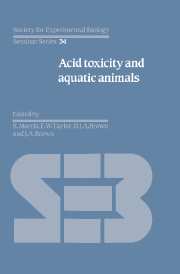Book contents
- Frontmatter
- Contents
- Contributors
- Units, Symbols and Formulae
- Preface
- Introduction: The causes and consequences of surface water acidification
- Invertebrate communities in acid streams
- Fish survival in acid waters
- Field studies on fisheries in acid waters in the UK
- Episodic changes in water quality and their effects on fish
- Acid–base regulation in fishes: 1. Mechanisms
- Acid–base regulation in fishes: 2. Biological responses and limitations
- Intracellular pH regulation and the effects of external acidification
- The physiological problems of fish in acid waters
- Laboratory studies on invertebrate survival and physiology in acid waters
- The physiological problems of crayfish in acid waters
- The effects of hydrogen and aluminium ions on fish gills
- The combined effects of pH and trace metals on fish ionoregulation
- Endocrine responses to acid stress in fish
- Commentary and conclusions
- Index
Endocrine responses to acid stress in fish
Published online by Cambridge University Press: 05 February 2012
- Frontmatter
- Contents
- Contributors
- Units, Symbols and Formulae
- Preface
- Introduction: The causes and consequences of surface water acidification
- Invertebrate communities in acid streams
- Fish survival in acid waters
- Field studies on fisheries in acid waters in the UK
- Episodic changes in water quality and their effects on fish
- Acid–base regulation in fishes: 1. Mechanisms
- Acid–base regulation in fishes: 2. Biological responses and limitations
- Intracellular pH regulation and the effects of external acidification
- The physiological problems of fish in acid waters
- Laboratory studies on invertebrate survival and physiology in acid waters
- The physiological problems of crayfish in acid waters
- The effects of hydrogen and aluminium ions on fish gills
- The combined effects of pH and trace metals on fish ionoregulation
- Endocrine responses to acid stress in fish
- Commentary and conclusions
- Index
Summary
Introduction
There is some consensus now that the death of many fish species, exposed to acid water, is caused by a chain of events starting with the loss of body electrolytes and eventually leading to osmoregulatory and cardiovascular failure (Muniz & Leivestad, 1980; McDonald & Wood, 1981; McDonald, 1983). Sublethal exposure to acidified water often leads to transient or chronic hypo-osmolarity of the blood plasma, mainly caused by reduced Na+ and Cl- levels (McWilliams, 1980; McDonald, 1983; Wendelaar Bonga, Van der Meij & Flik, 1984a). The severity and duration of these effects are determined by both external and internal factors. External factors, such as the calcium and aluminium concentration of the water and the presence of heavy metals, are dealt with by Wood, Potts & McWilliams, and McDonald et al. (this volume). The rate and degree of change of the environmental pH is also important. Internal factors, in particular hormones, are the subject of this chapter.
The endocrine system is of pre-eminent importance for the control of physiological processes that enable animals to adjust to changes in their environment. Since acidification of the water deeply affects many aspects of fish physiology, pronounced and multiple responses of the endocrine system may be envisaged. When it is taken into account that a predominant deleterious effect of acid water on fish is disturbed water and ion balance, it is not surprising that the hormones with osmoregulatory actions in fish, in particular cortisol, ACTH and prolactin, are given greatest consideration in this chapter. Studies on the effects of acid on fish endocrines are still scarce, and limited to a few species.
- Type
- Chapter
- Information
- Acid Toxicity and Aquatic Animals , pp. 243 - 264Publisher: Cambridge University PressPrint publication year: 1989
- 9
- Cited by



